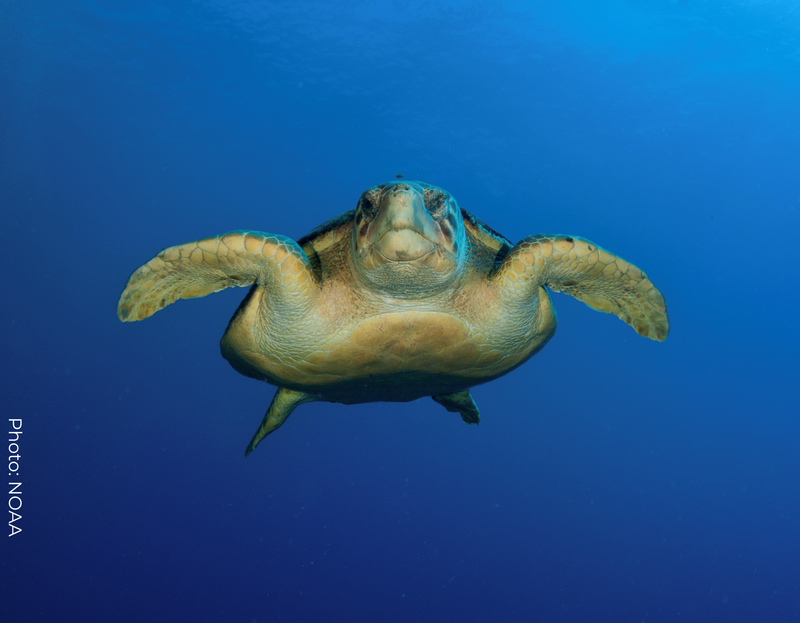
Recovery Planning Details
Decline on the Path to Recovery

Recovery Planning Details
Decline on the Path to Recovery
Every year from February to September, over 1,300 miles of the beaches in the southeastern U.S. are home to an astounding sight - the world’s largest hard shell turtle, the loggerhead sea turtle, coming ashore in huge numbers to nest in the sandy coastal habitat along the shores from Texas to Virginia. In a good year, these beaches can be the home of up to 90,000 nests. Then, 80 days later, under the cover of night, thousands of loggerhead sea turtle hatchlings dig out from the sandy nests and make their way toward the open ocean, using the light of the moon to navigate their way. Despite these astounding numbers, populations of loggerhead turtles have been on the decline, and in 1978, the loggerhead was listed as threatened under the Endangered Species Act (ESA). And the loggerhead is not alone - as of 2016, all five species of sea turtles in the United States are listed as threatened or endangered.
Listing under the ESA offers sea turtles several legal protections of the ESA, including protections from harm and destruction of habitat designated as critical for their populations. The ESA is the strongest law in the world for protecting imperiled wildlife like sea turtles, but how exactly does it work? The law has a lot of moving parts, and its effectiveness hinges on all these parts working the way they are supposed to. The seemingly minute details of how the law is implemented can have real, tangible impacts on the species the law is meant to protect.
Simply listing a species under the ESA isn’t enough to achieve the law’s goals of extinction prevention and recovery. What Congress recognized and has been the standard for decades is the need to develop and implement recovery plans to guide how we halt and reverse threats so that species are protected for the long-term. For the loggerheads and other sea turtles, for example, that means planning and taking steps to address threats like increased beach development and fisheries bycatch. And because threats can vary across a species’ range - much of the world’s oceans for sea turtles - we need to accommodate and plan for such differences.
An essential part of recovery plans are the criteria for when we can call a species “recovered,” which means when a species can be taken off the list of threatened and endangered species. These criteria could be measured as the number of individuals or populations needed, a required amount of habitat protected, or more. You would assume that if a species has been listed as threatened or endangered, that any recovery plan would by necessity require an improvement before it could be delisted. However, research has found that about 10% of listed species are allowed to “decline on the path to recovery,” that is, be considered recovered even with fewer populations or individuals than existed at the time of listing or plan writing. While this seems counterintuitive - how can we have fewer of a listed species but consider it conserved for the long-term? - the science might support it. For example, if we put in place long-term plans to curb beach disturbance and development in the Southeast, we might expect that the West Atlantic loggerhead population will be effectively conserved even if there are fewer than in the past.
A new study from Defenders and partners in and out of academia focused on 130 ESA-listed species that can decline but be declared recovered, asking specifically about the scientific support for those recovery targets. Unfortunately, the researchers found that almost none of the recovery plans for those species clearly explained or provided scientific justification for why such a decline is allowed. In other words, even though these species were already in danger, it may be that FWS set their “recovery” goals too low.
“With hundreds of species lacking recovery plans or badly needing plan revisions - the median recovery plan is over 22 years old - it is essential that the Fish and Wildlife Service incorporate our findings and use sound science to guide any plan updates. It is acceptable if scientists judge that population declines may be allowed and still allow the true recovery of species, but we shouldn’t allow non-scientific reasons to set the bar for the conservation too low.”
~ CCI Director Malcom, study coauthor
Recovery planning is a critical part of the government’s responsibilities under the ESA, and how those plans are developed and carried out need to be rigorous and justified by the science. Otherwise, a supposedly “recovered” species may quickly find itself on the brink of extinction, a situation we do not want for loggerheads or any other species.